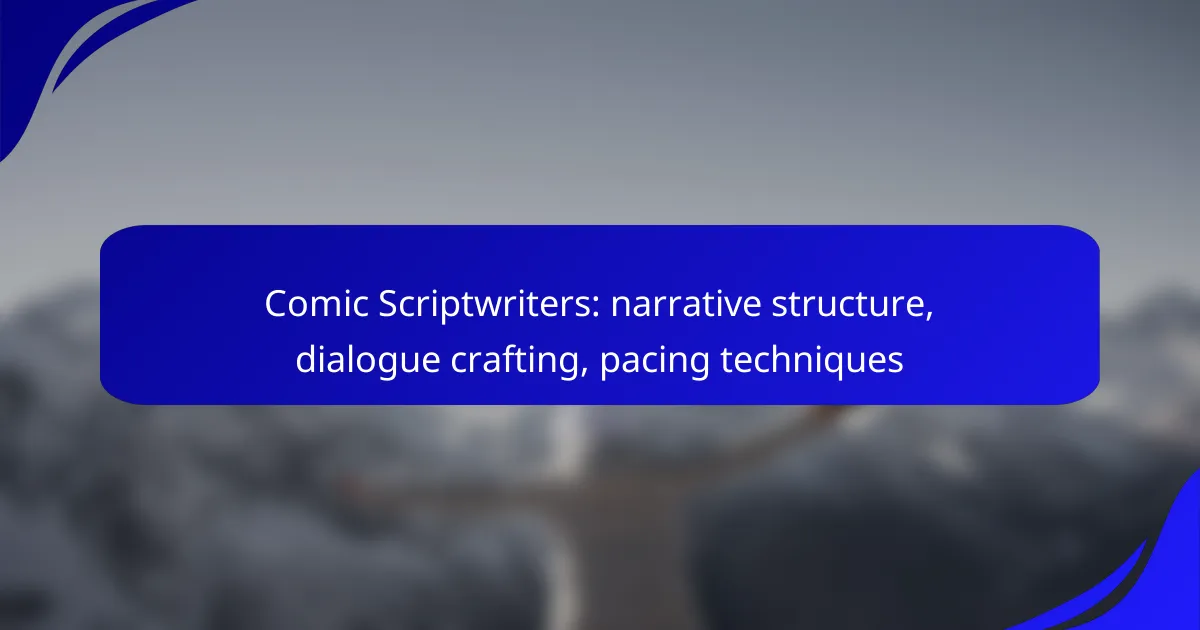Comic scriptwriters play a crucial role in shaping narratives through structured frameworks that enhance storytelling. By utilizing techniques for crafting authentic dialogue and managing pacing, they create engaging and dynamic comic experiences that resonate with readers. Understanding these elements is essential for developing compelling characters and maintaining narrative momentum.
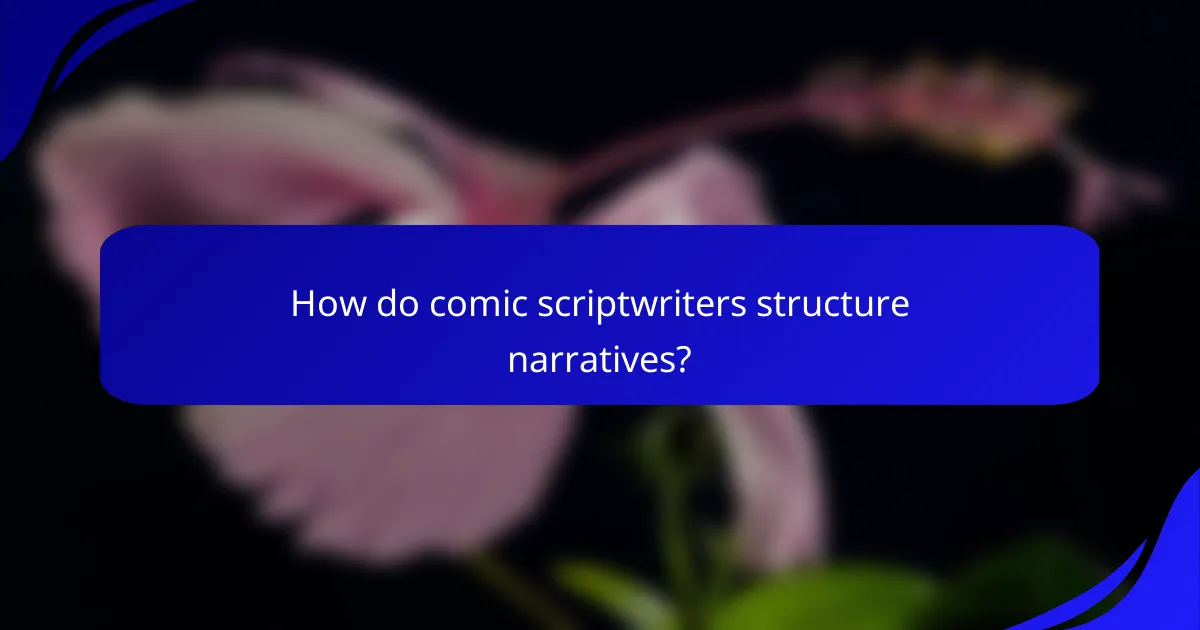
How do comic scriptwriters structure narratives?
Comic scriptwriters structure narratives using various frameworks that help organize the story effectively. Common structures include the three-act structure, the hero’s journey, and non-linear storytelling, each offering unique approaches to pacing and character development.
Three-act structure
The three-act structure divides a narrative into setup, confrontation, and resolution. In the first act, characters and settings are introduced, establishing the story’s premise. The second act escalates conflict, leading to a climax, while the third act resolves the story’s tensions, providing closure.
This structure is popular because it creates a clear arc that guides readers through the narrative. For example, a comic might start with a hero discovering their powers (setup), face challenges from a villain (confrontation), and ultimately defeat them (resolution).
Hero’s journey
The hero’s journey is a narrative framework that follows a protagonist through stages of adventure, transformation, and return. It typically includes elements like the call to adventure, crossing the threshold, and the return with newfound wisdom. This structure resonates with audiences as it reflects universal themes of growth and self-discovery.
In comics, this might manifest as a character who leaves their ordinary world, faces trials, and returns changed. For instance, a young hero might start in a mundane town, venture into a magical realm, and return to save their community with new skills.
Non-linear storytelling
Non-linear storytelling presents events out of chronological order, allowing for a more complex narrative experience. This technique can create suspense and deepen character exploration by revealing backstory and motivations at strategic points. It often requires careful planning to ensure clarity for the reader.
In comics, this might involve flashbacks or parallel storylines that intersect at key moments. A writer should ensure that transitions are clear to avoid confusing the audience. For example, a character’s past might be revealed in snippets throughout the story, enhancing the present-day narrative.
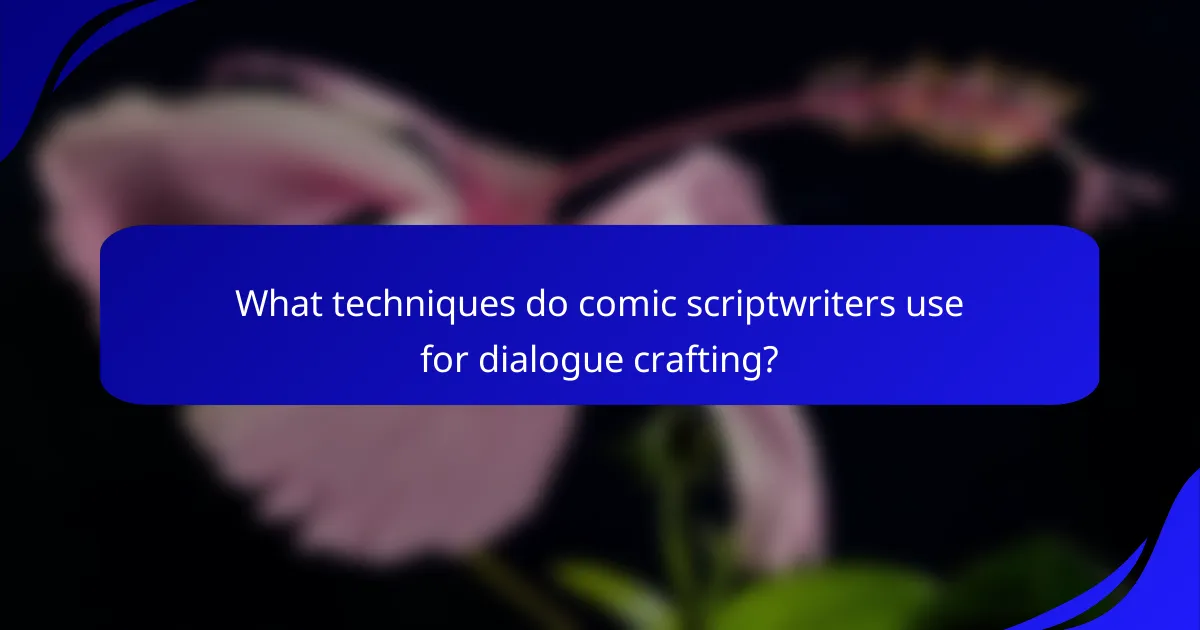
What techniques do comic scriptwriters use for dialogue crafting?
Comic scriptwriters employ various techniques for dialogue crafting to create engaging and believable conversations. These methods enhance character development, convey subtext, and ensure that speech patterns feel authentic and relatable.
Character voice development
Character voice development involves creating distinct speech styles that reflect each character’s personality, background, and motivations. Writers should consider factors such as age, education, and cultural influences when shaping a character’s dialogue. For instance, a young, urban character might use slang, while an older character might employ more formal language.
To maintain consistency, writers can create a voice guide that outlines key phrases, vocabulary, and speech quirks for each character. This guide helps ensure that characters remain true to their established voices throughout the narrative.
Subtext in dialogue
Subtext refers to the underlying meaning or emotions conveyed through dialogue, often contrasting with the literal words spoken. Effective use of subtext can add depth to conversations, allowing readers to infer feelings and intentions without explicit statements. For example, a character saying “I guess I’ll see you around” might imply disappointment or avoidance, depending on the context.
Writers should aim to balance direct statements with subtext, ensuring that dialogue feels natural while still conveying deeper themes. This technique can create tension and intrigue, encouraging readers to engage more actively with the story.
Realistic speech patterns
Realistic speech patterns mimic how people actually communicate, incorporating elements like interruptions, incomplete thoughts, and colloquialisms. Writers should pay attention to how conversations flow in real life, using pauses and overlaps to create a more dynamic dialogue. For instance, a character might start a sentence but get interrupted, reflecting how conversations often unfold.
To achieve realistic speech, writers can listen to conversations in everyday settings or study scripts from films and television. This practice helps identify common speech habits and rhythms, which can then be adapted to fit the comic’s tone and style.

How do comic scriptwriters manage pacing?
Comic scriptwriters manage pacing by carefully controlling the flow of the narrative through visual and textual elements. This involves balancing the timing of panel transitions, the rhythm of dialogue, and the intensity of action sequences to create an engaging reading experience.
Panel transitions
Panel transitions are crucial for pacing, as they dictate how quickly a reader moves through the story. Writers can use various types of transitions, such as moment-to-moment, action-to-action, or scene-to-scene, to influence the speed of the narrative. For instance, quick transitions can heighten tension, while slower transitions allow for reflection and character development.
When planning panel transitions, consider the emotional tone of the scene. A series of rapid transitions can convey urgency, while lingering on a single panel can emphasize a significant moment. Aim for a mix that aligns with the story’s rhythm and keeps the reader engaged.
Dialogue pacing
Dialogue pacing involves the timing and flow of conversations between characters. Effective dialogue should reflect the characters’ emotions and the scene’s tension, using techniques like interruptions, pauses, and varying speech lengths. Short, snappy exchanges can create a fast pace, while longer, more thoughtful dialogue can slow the narrative down.
To enhance dialogue pacing, consider the use of visual cues such as speech bubbles and their placement. For example, overlapping dialogue can suggest urgency or conflict, while isolated speech can draw attention to important revelations. Always aim for a natural rhythm that feels authentic to the characters.
Action sequences
Action sequences are pivotal for maintaining an energetic pace in comics. Writers should focus on clarity and impact, ensuring that each action is easy to follow while still conveying excitement. Using dynamic panel layouts and varying the size of panels can help emphasize key moments and maintain momentum.
When crafting action sequences, consider the balance between visual storytelling and dialogue. Too much dialogue can slow down the action, while too little can leave readers confused. A good rule of thumb is to let the visuals drive the action while using dialogue sparingly to enhance the stakes or character motivations.
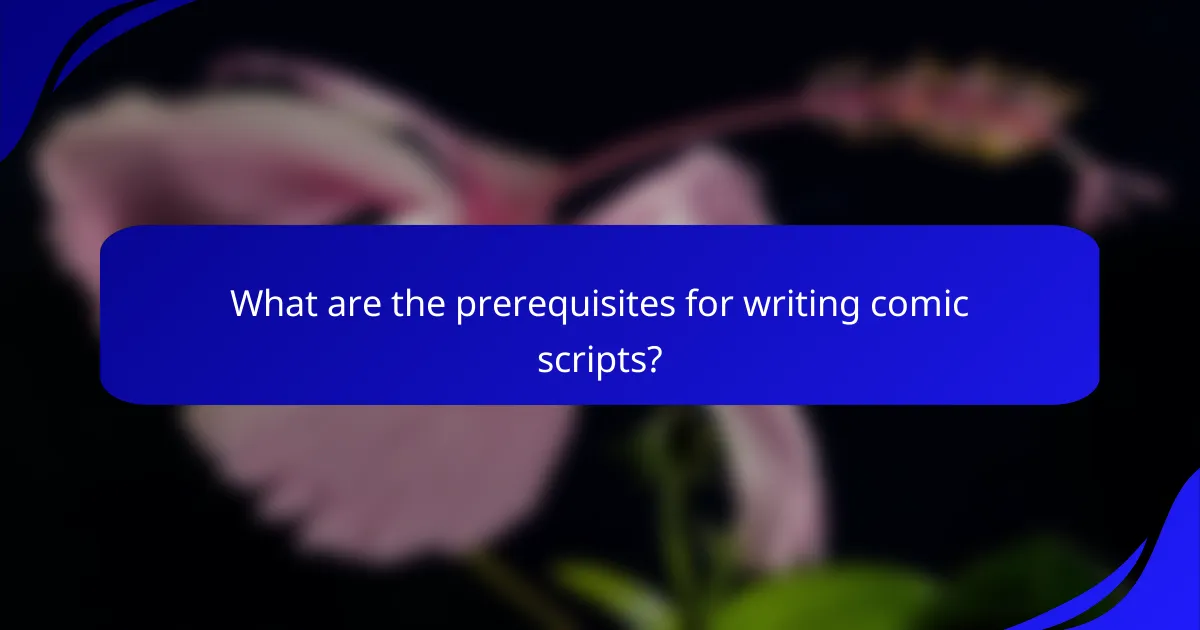
What are the prerequisites for writing comic scripts?
Writing comic scripts requires a solid understanding of narrative structure, dialogue crafting, and pacing techniques. Familiarity with comic book formats and visual storytelling is essential to effectively convey the story through both text and images.
Understanding comic book formats
Comic book formats vary widely, including single issues, graphic novels, and webcomics. Each format has its own conventions regarding page count, panel layout, and pacing, which influence how the story unfolds. For instance, a standard comic issue typically contains around 20-30 pages, while graphic novels can range from 60 pages to over 200.
When writing for comics, it’s crucial to consider the layout of panels and the flow of the narrative. Writers should be aware of how many panels fit on a page and how to use them to control pacing. For example, a single large panel can create a dramatic moment, while multiple smaller panels can speed up action sequences.
Familiarity with visual storytelling
Visual storytelling is the backbone of comic scripts, where images and text work together to convey the narrative. Writers must think visually, considering how characters, settings, and actions will be depicted. This means writing descriptions that are clear and concise, allowing artists to interpret the script effectively.
Additionally, understanding the interplay between dialogue and visuals is vital. Dialogue should enhance the artwork, not overshadow it. Writers should aim for a balance, ensuring that speech bubbles complement the visual elements without cluttering the page. A common pitfall is overloading panels with text, which can detract from the artwork and confuse readers.
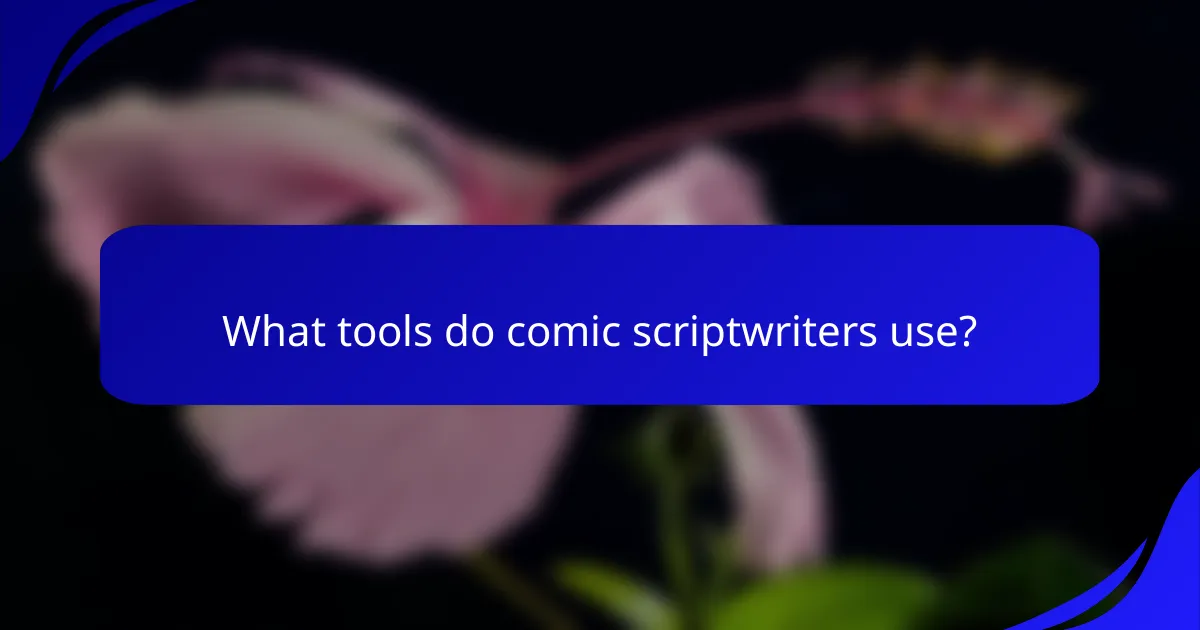
What tools do comic scriptwriters use?
Comic scriptwriters utilize various tools to enhance their storytelling, streamline the writing process, and visualize their narratives. These tools help in organizing scripts, planning visuals, and refining dialogue, ultimately leading to a more cohesive comic book or graphic novel.
Celtx for scriptwriting
Celtx is a popular scriptwriting software that provides a structured environment for comic writers. It offers templates specifically designed for comics, allowing writers to format their scripts easily and focus on narrative flow and dialogue.
One of the key features of Celtx is its collaboration tools, which enable multiple writers and artists to work on a project simultaneously. This can significantly enhance creativity and efficiency, especially in larger teams. Writers should take advantage of Celtx’s cloud storage to access their scripts from anywhere.
Storyboard That for visual planning
Storyboard That is an effective tool for visual planning in comic creation. It allows scriptwriters to create storyboards that illustrate key scenes, helping to visualize the pacing and layout of the comic. This can be particularly useful for determining how dialogue and action will flow across panels.
Using Storyboard That, writers can drag and drop characters, backgrounds, and props to build scenes quickly. This visual representation aids in identifying potential pacing issues and ensures that the narrative remains engaging. Writers should consider using this tool during the early stages of script development to refine their ideas before finalizing the script.
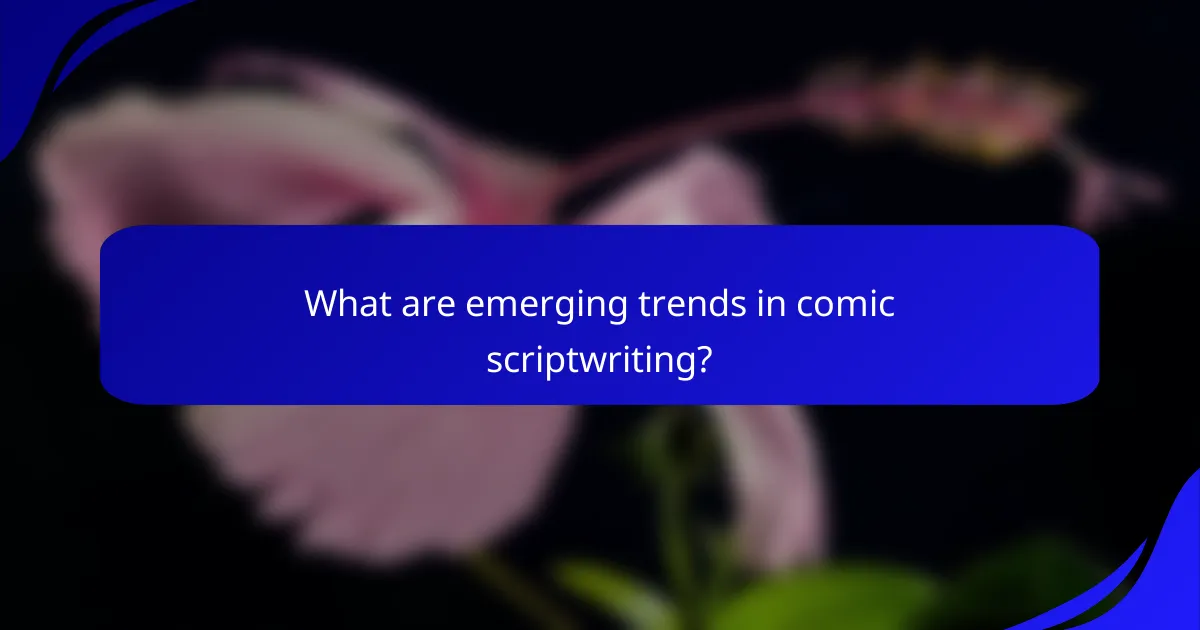
What are emerging trends in comic scriptwriting?
Emerging trends in comic scriptwriting focus on diverse storytelling techniques, character development, and the integration of multimedia elements. Writers are increasingly exploring unique narrative structures and innovative dialogue crafting to engage modern audiences.
Narrative Structure
Comic scriptwriters are experimenting with non-linear narratives and multiple perspectives to create more engaging stories. This approach allows for deeper character exploration and can enhance the emotional impact of the plot. Writers should consider how the structure affects pacing and reader comprehension.
For instance, using flashbacks or parallel storylines can add complexity, but it’s important to maintain clarity. A common pitfall is overwhelming the reader with too many timelines, so balancing complexity with coherence is essential.
Dialogue Crafting
Effective dialogue in comics is concise and impactful, often reflecting the character’s personality and emotional state. Writers are focusing on natural speech patterns and subtext to convey deeper meanings without lengthy exposition. This trend emphasizes the importance of brevity and wit in dialogue.
To craft compelling dialogue, consider the character’s background and motivations. Avoid clichés and strive for authenticity. A useful tip is to read dialogue aloud to ensure it sounds natural and fits the character’s voice.
Pacing Techniques
Pacing in comic scriptwriting is crucial for maintaining reader engagement. Writers are utilizing techniques like varying panel sizes and layouts to control the flow of the story. Quick, action-packed sequences can be contrasted with slower, more introspective moments to create rhythm.
One effective method is to use larger panels for significant moments and smaller ones for rapid actions. This visual pacing can enhance the storytelling experience. Additionally, be mindful of the balance between dialogue and visuals, ensuring that neither overwhelms the other.
